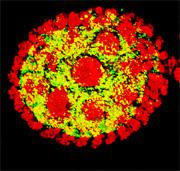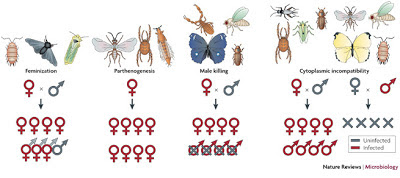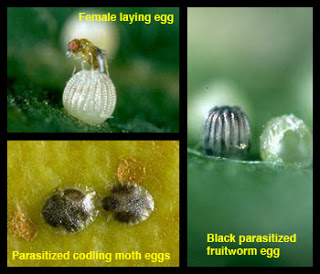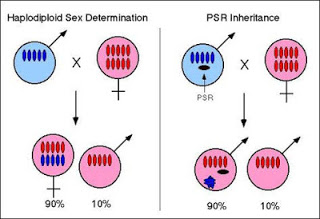Biology
Henry VIII went through six wives in an attempt to generate a male heir to the throne. Some died, some were killed, some were divorced and banished. Producing a boy was apparently a very big deal to him (and to the country).
The various species of Wolbachialive in the cellular cytoplasm of arthropod (insects, wasps, mites, etc.) and some nematodes (roundworm). It requires room to reproduce and release its progeny, so there needs to be sufficient cytoplasm for its life cycle to proceed. Since it is transmitted vertically, that means that it should be found in the egg of the female and the sperm of the male ? but it isn?t in the sperm.
In some hosts, the bacteria will induce feminization, turning males into females. In others, it will simply kill off the male progeny while they are still embryos. In still more hosts, they induce an incompatibility between the male cytoplasm and the female cytoplasm during fertilization, resulting in the elimination of the male characteristics. But for my money, the neatest way that Wolbachiacan assure daughters is by inducing parthenogenesis.
Why would it go to the trouble of killing males in such a short time frame? This may ensure bacterial survival in female lines, but it also appears that the host aphid benefits from male killing in some way, since the reproductive stages where male killing occurs persist despite the loss of nearly 50% of the male offspring.
Trichogramma wasps are parasitic organisms that are used to control certain moths and their caterpillar larvae in orchards and on vegetable crops. They are very small (about 4-5 could fit on the head of a pin), and they lay their eggs inside the eggs of certain moths. When their eggs hatch, they eat the moth eggs and prevent the development of the caterpillar that does so much damage.
A new study has shed light on just how the PSR chromosome induces male production in haplodiploids. Published in 2012, Swim and colleagues showed that in another wasp species that carries the PSR chromosome, the function of the PSR genes is to modify the paternal chromosomes in such a way that they do not condense during mitosis.
Swim, M., Kaeding, K., & Ferree, P. (2012). Impact of a selfish B chromosome on chromatin dynamics and nuclear organization in Nasonia Journal of Cell Science, 125 (21), 5241-5249 DOI: 10.1242/jcs.113423
Simon, J., Boutin, S., Tsuchida, T., Koga, R., Le Gallic, J., Frantz, A., Outreman, Y., & Fukatsu, T. (2011). Facultative Symbiont Infections Affect Aphid Reproduction PLoS ONE, 6 (7) DOI: 10.1371/journal.pone.0021831
- 1. Reproduction In Organisms
Click here for PDF- Reproduction is a process in which an organism gives rise to young ones (offspring) similar to itself. - The period from birth to the natural death of an organism represents its life span. - ...
- The Yolk?s On You
Biology concepts ? parthenogenesis, avian reproductive system Some people practice a form of vegetariansim called veganism. The definition of vegan can be different from person to person, but generally it means that one does not consume or use animal...
- Males ? Can?t Live Without Them?
Biology concepts ? parthenogenesis, gynogenesis, kleptogenesis, sperm-dependent parthenogenesis, pseudogamy, Muller?s ratchet Last week we introduced the idea that species can be (facultative) or must be (obligate) parthenogenic. Both facultative and...
- Just Leave The ?father? Line Blank
Biology concepts ? apomixis, automixis, genomic imprinting, haplodiploid, facultative and obligate parthenogenesis Kids questions can be exasperating, exhilarating, and problematic ?all at the same time. Questions about biology are especially difficult...
- Every Day Should Be Mother?s Day
Biology concepts ? inheritance patterns, mitochondria, fertilization, lineage, mitochondrial Eve What do the ?The Battle Hymn of the Republic?, Mother?s Day, and all your mitochondria all have in common? Julia Ward Howe wrote the words for The Battle...
Biology
A Marriage Of Inconvenience
Biology concepts ? parasitic parthenogenesis, parental sex ratio chromosome
 |
Henry the VIII had not quite divorced Catherine by the time Anne Boleyn caught his eye, although she was said to have six fingers and a large mole or goiter on her neck, so just how she caught his eye is up for grabs. She had a girl, the future Queen Elizabeth I, and then a stillborn child. This sealed her fate with Henry, and she was the first to lose her head over the situation of a male heir for Henry. |
Believe it or not, there are bacteria that wield more power than the King of England. Some intracellular bacteria are powerful enough to dictate the sex of their host?s children. It would have been so much easier on the women of Henry VIII?s life if they just could have been infected with Wolbachia, the best studied of these bacteria - oops, maybe not.
Wolbachia is a gram negative bacterium related to Rickettsia (one rickettsia is the cause of Rocky Mountain Spotted Fever ? a lethal infection) is symbiotic with its host, but it could be considered commensal. Remember that commensalism is a type of symbiosis where one organism benefits, but the other is unaffected. In a strange way, even though Wolbachia will bias the sex of the offspring, it is not exactly a parasite. It does not kill the host, so the species does live on. Also, the physiology of the individual is not affected beyond the behavior of its ?sex ratio distorter? guest. On the other hand, Wolbachia does prevent males from being born, so I?m sure they would consider it a parasite.
To ensure its own survival, Wolbachiahas developed a system in which it is transmitted vertically; that is, from mother to offspring. By doing this, it avoids the cold cruel world outside its host, including all the potential predators and environmental conditions that could kill it off before it found a new host.
 |
This is a Drosophila fruit fly egg. The yellow dots are all Wolbachia bacteria. You can see that they need a lot of cytoplasm, so it behooves them to force production of females (more eggs). This vertical transmission is not rare, and usually does not result in harm to the host ? why bite the hand that feeds you. |
When you compare a sperm and an ovum, there is relatively little cytoplasm in the sperm; too little to support dividing Wolbachia. Therefore, males can't contribute to the vertical transmission of the bacterium. As a result, any host that produces sperm is a literal dead end for our cytoplasmic guest ? males are nothing but a graveyard for the Wolbachia.
What do you think evolution has done to alleviate this problem for the bacterium? Wolbachiahas learned to turn all the host offspring into females! It travels from mom to daughter in every case, because every child is a daughter.
So how does Wolbachiago about assuring that only females are born, thereby guaranteeing its passage to the next generation? Different species of the bacteria have different hosts and completely different strategies for inducing a female sex bias.
 |
There are four ways that Wolbachia can bias the sex of offspring in different arthropods. Examples of the species in which mechanism works is on top, and the symbols for how it works are down low. Feminization turns male embryos into females. Parthenogenesisstimulated diploid egg production and development. Male killing just gets rid of any male embryo produced. Cytoplasmic incompatibility means that infected males won?t produce offspring with uninfected females, so infected females are preferentially represented in the offspring. |
Even in the induction of parthenogenesis, Wolbachia can vary its strategies. In some species of wasps, the bacterium causes a fusion of the gametes after meiosis. Remember that wasps and other hymenopterans are haplodiploid in their sex determination. Diploid eggs are a result of fertilization and generate females (XX), while unfertilized eggs are haploid and produce males (XO).
By forcing the fusion of two haploid eggs, the result is a diploid egg that is then induced to develop and generates an XX embryo -- Voila ? a daughter! This turns out to be a every efficient way for Wolbachia to increase its own survival, so much so that in certain haplodiploid genera, EVERY known species is obligately parthenogenic and infected with Wolbachia!
However, there is an exception to this haplodiploid mechanism of sex distortion ? there's always an exception. In a series of experiments on mites, Weeks and his colleagues found that all the parthenogenic haplodiploid mite species they chose to study were infected with Wolbachia, but that the daughters were full clones of the mother, not automictic half-clones as would be produced by fusion of the gametes in the wasp example above. In the mite species, Wolbachia induced an endomitosis, so the egg itself duplicated its chromosomes without meiosis and developed from that point, not from the fusion of two egg cells. Wolbachiais imaginative if nothing else.
Just to prove how good a survival strategy altering sex ratios in vertically transmitted symbiots is, several other organisms have evolved it independently. Spiroplasmais a bacterium that induces a sex distortion in pea aphids by killing off the males. This seems odd, since pea aphids have a cyclic reproduction cycle; most of the year the females undergo parthenogenesis and produce female clones. Only a small part of the year do they complete sexual reproduction and produce males and females. It is in this time period that the Spiroplasma kills the male embryos.
 |
Spiroplasma is a bacterium that shows you how it got its name, it looks a corkscrew and moves in a spiral fashion. Some species infect arthropods, while others infect plants, like corn or citrus trees. In either case, they live intracellularly. In plants, they cause diseases like ?Citrus Stubborn Disease? and ?Corn Stunt Disease.? |
A study by Simon et al. on Spiroplasma induction of male killing in the pea aphid hypothesizes that in species of aphid that are less dispersive, ie. more generations spend time on the same plant, there is decreased fitness in sexually reproduced offspring. By inducing male killing, it reduces the chance of inbreeding depression and loss of fitness. Everybody wins.
Other examples of forcing production of females do exist. There is the bacterium, A. nasoniae, that is a male embryo killer in wasps. There is a trematode (fluke worm) called Leucochloridiomorpha constantiae that very likely induced the development of parthenogenesis in a freshwater snail. The trematode dines on sperm in the mated female, causing a sperm deficit. Parthenogenesis likely resulted as a survival strategy in the sperm starved ova.
By no means lastly, but the last one I will mention, is the microsporidian (a small type of bacterium) Nosema granulosis that lives inside in a small crustacean called an amphipod. N. granulosis turns male crustaceans into female crustaceans (feminization), but this isn't all bad for the the little shrimp. It turns out that this somehow confers a survival advantage to the amphipod. This was first reported by Dr. Thierry Rigaud's group in Dijon, France in 2007.
I asked Dr. Rigaud how a feminizing parasite could increase survival and he said, "perhaps females have an innate advantage in survival compared to males (this would fit the life-history trait theory postulating that the female sex invests more in survival while males invest more in reproduction). However, in the case of our experiment, the survival was measured during the pre-reproductive period. Therefore, here, males did not invest in reproduction, so that an increased investment in reproduction cannot explain an increased death rate compared to females." So for now, the answer is.... we don't know. But female humans survive longer than males, so if the human race was mostly female, it would look like that just being female would be providing some survival advantage as well - maybe girls know something guys don't.
I asked Dr. Rigaud how a feminizing parasite could increase survival and he said, "perhaps females have an innate advantage in survival compared to males (this would fit the life-history trait theory postulating that the female sex invests more in survival while males invest more in reproduction). However, in the case of our experiment, the survival was measured during the pre-reproductive period. Therefore, here, males did not invest in reproduction, so that an increased investment in reproduction cannot explain an increased death rate compared to females." So for now, the answer is.... we don't know. But female humans survive longer than males, so if the human race was mostly female, it would look like that just being female would be providing some survival advantage as well - maybe girls know something guys don't.
But guys, all is not lost. If you are reader of this blog, you know that for every right cross that evolution throws at a species, a block and a nasty uppercut are soon to follow. If they didn?t, we would be talking in the past tense ? that species would be extinct. Evolution is an escalating war of offense and defense, and in the case of Wolbachia, a parasitic wasp has developed a good tool to keep the bacterium at bay.
 |
The fly in the top left is a Trichogramma. It lays its eggs inside the moth egg. The lower picture shows how the parasites grow inside the moth eggs, they appear as dark spots. Eventually, the infected eggs will turn all black, as shown in the right image. |
T. kaykai males carry an extra chromosome, called the PSR chromosome. PSR stands for ?parental sex ratio,? and it functions to force production of males on the females. After the first mitosis in embryos that carry the PSR chromosome, all the male chromosomes (except PSR) are lost. This makes the fertilized embryo haploid again, and therefore male.
Modeling experiments showed that with significant sibling mating (brothers and sisters from the same queen), this forcing of male production could keep Wolbachiainfection in the population at about 10%. This way, some lines could clear the infection by producing uninfected males, and mating of them to sisters could produce uninfected moms. These moms would be free to have both male and female offspring. Take that Wolbachia!!
So the PSR chromosome is also a sex ratio distorter. It assures its own passage to the next generation since it is only carried in the sperm father to son. No wonder Richard Dawkins entitled his classic book on genetics and evolution, ?The Selfish Gene? - everybody is out for themselves. And that is the key to evolution, he who persists in the offspring wins, no matter what tricks he has to play to achieve it.
 |
In haplodiploid sex determination, haploid embryos are male. If the males contain the PSR chromosome, the female embryos are degraded back to haploid and all males are produced. The ratios go from 90:10 female to 100% male. Notice that even thought the PSR chromosome is from the male, it escapes destruction in the embryo. |
If the paternal chromosomes don?t condense, they can?t be transferred to the daughter cells, so they are lost forever. However, the PSR chromosome itself is located on the periphery of the complex that modifies the paternal chromosomes, so it escapes modification and can be passed to the daughter cells. Hence, it forces haploidy and male production, but maintains itself in the male offspring for passage to the next generation. Amazing.
Next week, we will start a new series tackling the differences between venom and toxin, and the weird organisms that make one when all their kin get along without it ? a venomous plant? A poisonous bird?
For more information, see:
Wolbachia ?
http://arstechnica.com/science/2011/10/meet-wolbachia-the-male-killing-gender-bending-gonad-chomping-bacteria/
http://io9.com/5748195/bug-to-spider-i-will-control-your-offsprings-sex
http://www.rochester.edu/college/bio/labs/WerrenLab/WerrenLab-WolbachiaBiology.html
http://serc.carleton.edu/microbelife/topics/wolbachia/index.html
http://www.eliminatedengue.com/our-research/wolbachia
http://www.plospathogens.org/article/info%3Adoi%2F10.1371%2Fjournal.ppat.1002043
http://www.plosbiology.org/article/info%3Adoi%2F10.1371%2Fjournal.pbio.0050114
http://www.plosone.org/article/info:doi/10.1371/journal.pone.0030045
http://bioteaching.wordpress.com/2012/09/13/wolbachia/
http://books.google.com/books?id=qnJqJ67YqEEC&pg=PA92&lpg=PA92&dq=wolbachia+feminization%27&source=bl&ots=xv0yg1M46r&sig=Q007tMUVxqA15ekSAVVW7VaW7CA&hl=en&sa=X&ei=xeEbUf6MF8uz0QHuq4CYAg&ved=0CE4Q6AEwBA#v=onepage&q=wolbachia%20feminization%27&f=false
http://www.google.com/url?sa=t&rct=j&q=&esrc=s&source=web&cd=10&ved=0CGMQFjAJ&url=http%3A%2F%2Fcourses.umass.edu%2Fmic590s%2F2009%2FReading%2FWerren2008.pdf&ei=xeEbUf6MF8uz0QHuq4CYAg&usg=AFQjCNEylUgYQ_DD0bWFtt8lvyNO3IK9pw
http://users.rcn.com/jkimball.ma.ultranet/BiologyPages/A/AsexualReproduction.html
PSR chromosome ?
http://student.biology.arizona.edu/honors98/group15/psr.htm
http://www.rochester.edu/college/bio/labs/WerrenLab/Selfish_Genes.html
http://www.ncbi.nlm.nih.gov/pubmed/12656576
www.rochester.edu/college/bio/labs/.../2003_GeneticaPSR.pdf
http://books.google.com/books?id=Pj7qnU-cF6YC&pg=PA198&lpg=PA198&dq=PSR+chromosome&source=bl&ots=H8u206Sy_S&sig=rNXZd1BBNLbepXE2bany6zChejk&hl=en&sa=X&ei=f-IbUe2KGpS70AGqvoBg&ved=0CF0Q6AEwCTgK#v=onepage&q=PSR%20chromosome&f=false
http://www.narcis.nl/research/RecordID/OND1307202/Language/en
http://books.google.com/books?id=u2X-rfgU0ewC&pg=PA158&lpg=PA158&dq=PSR+chromosome&source=bl&ots=Qh2AvI5t5Y&sig=27K65LyCTarnF3Xb_L9g3rv-6cE&hl=en&sa=X&ei=ouIbUaDrFKnD0AHL94DYAw&ved=0CFcQ6AEwBjgU#v=onepage&q=PSR%20chromosome&f=false
- 1. Reproduction In Organisms
Click here for PDF- Reproduction is a process in which an organism gives rise to young ones (offspring) similar to itself. - The period from birth to the natural death of an organism represents its life span. - ...
- The Yolk?s On You
Biology concepts ? parthenogenesis, avian reproductive system Some people practice a form of vegetariansim called veganism. The definition of vegan can be different from person to person, but generally it means that one does not consume or use animal...
- Males ? Can?t Live Without Them?
Biology concepts ? parthenogenesis, gynogenesis, kleptogenesis, sperm-dependent parthenogenesis, pseudogamy, Muller?s ratchet Last week we introduced the idea that species can be (facultative) or must be (obligate) parthenogenic. Both facultative and...
- Just Leave The ?father? Line Blank
Biology concepts ? apomixis, automixis, genomic imprinting, haplodiploid, facultative and obligate parthenogenesis Kids questions can be exasperating, exhilarating, and problematic ?all at the same time. Questions about biology are especially difficult...
- Every Day Should Be Mother?s Day
Biology concepts ? inheritance patterns, mitochondria, fertilization, lineage, mitochondrial Eve What do the ?The Battle Hymn of the Republic?, Mother?s Day, and all your mitochondria all have in common? Julia Ward Howe wrote the words for The Battle...
